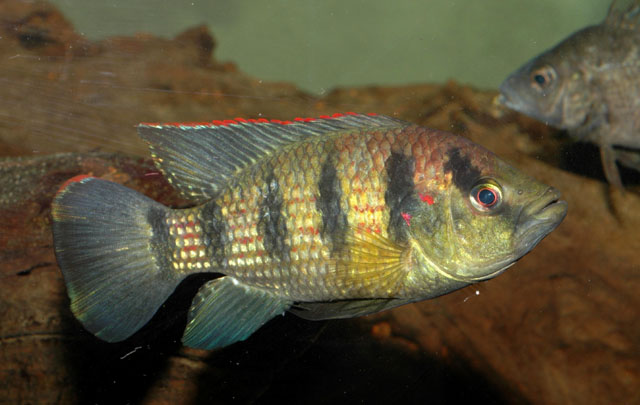| Africa: widely distributed in the coastal rivers of Lower Guinea, from the Ntem in Cameroon to Kouilou basin in Republic of Congo, including the Woleu, Ogowe and Nyanga rivers (Ref. 81260, 123791). Also in the Dja River, an affluent of the Middle Congo basin (Ref. 123791). Populations from entire Congo River basin and southern African basins, including Okavango, Zambesi and Cuanza (Ref. 11970, 120641), are also considered as conspecific (Ref. 123791), and may represent a distinct species (Ref. 81260). Also reported from West Africa in Guinea, Sierra Leone, Liberia, Togo, Benin and Nigeria (Ref. 43352, 81260), but this needs confirmation (Ref. 53405). |
|
Dorsal spines (total): 13-16; Dorsal soft rays (total): 11-13; Anal spines: 3-3; Anal soft rays: 7-10. Diagnosis: Hemichromis elongatus can be distinguished from H. camerounensis by the presence of a single red opercular spot or a mixture of reddish and yellowish spots dorsally of the large black opercular spot instead of two red opercular spots on the both sides of the black spot in H. camerounensis (Ref. 123791). It can be distinguished from H. fasciatus by the absence of small black dots between the first three dark stripes on the sides of the body of adults (Ref. 123791). With 4-5 distinct blotches or ovoid bars along lateral mid-line (Ref. 44091, 81260), but bands not obvious in large males which assume a very dark to almost black coloration (Ref. 44091). Scales olive to yellow; series of thin red dots often forming horizontal lines along the mid-portion of flanks; normally 2 rows of teeth on upper jaw (Ref. 81260). Magenta spot on gill cover (Ref. 44091).
Description: General body shape moderately deep and elongated, body depth 31.3-39.4% of standard length ; dorsal and anal fins reaching caudal fin origin; dorsal fin straight or slightly convex, soft rays 5 to 7 longest; length of pectoral and pelvic fin rays decreasing from first to last branched rays; caudal fin emarginate or truncate, caudal peduncle almost as long as deep; cycloid scales (Ref. 81260, 123791). Head narrow and long, its length 35.5-39.0% of standard length, with straight or moderate concave profile, premaxillary pedicel long; snout long and acute; mouth (almost) isognathous, prominent with highly protrusile upper jaw; lower jaw markedly prognathous; lower lip fold broad, completely covers upper lip at corner of mouth; eye diameter intermediate; lower pharyngeal jaw moderately broader than long and V-shaped, somewhat convex, with 19-26 marginal teeth; upper jaw with two rows of teeth, outer row with a few slightly enlarged canines near symphysis, inner row of tiny unicuspids separated from outer row by a wide gap (Ref. 81260, 123791). Rakers near ceratobranchial-epibranchial angle often distally flattened and anvil-shaped; first pelvic ray longest in both sexes; some dorsal and anal fin rays elongated; chest scales smaller than body scales (Ref. 81260). Upper lateral line scales 16-19, lower lateral line scales 8-12, longitudinal line scales 28-30, upper transverse line scales 3-5, lower transverse line scales 8-10, pectoral to pelvic fins range scales 4-7, caudal peduncle rows scales 15-16, cheek scales 4-6 (Ref. 123791).
Colouration: Colour of living specimens: general colour pattern grey-silverish, with five large dark vertical stripes, rarely six, on the flanks, sometimes condensed as large dark blotches; scales on the flanks marked at edges by grey or silver colour and at centre by yellow or goldenish colour; a short dark band sometimes present between the two first large stripes on flanks; operculum with a single red opercular spot or a mixture of a few red and yellowish spots dorsally of the large black opercular spot; dorsum grey-silver to yellowish intersected by large dark vertical stripes; ventral parts of body and head, chin and cheeks red; dark lachrymal stripe extending over iris and above eye; fins grey or whitish (Ref. 81260, 123791). Opercular spot very well-developed and prominent (Ref. 81260). With 4-5 prominent black blotches (Ref. 52307, 81260), or elongated ovoid bars along lateral mid-line to caudal peduncle base (Ref. 81260). Throat and venter normally creamy or rosy (Ref. 52307). In breeding, colouration of most of the venter dusky grey to black while flanks are often flushed deep red (Ref. 81260), and black spots on body disappear, replaced by pale blotches (Ref. 52307). A series of small red dots, often forming thin red lines, run along the flanks (Ref. 52307, 81260). These are mostly concentrated in the mid-lateral region, becoming less intense dorsally and ventrally; dorsal fin, and sometimes upper part of caudal fin, with thin red margin and often a thin white submargin; pectorals hyaline, other fins yellowish to dusky grey; a narrow dark lachrymal stripe usually present; juveniles (< 15 mm) yellow or pale brownish with a very strong and prominent mid-lateral black band (Ref. 81260). Young and non-territorial individuals sometimes with off-white cheeks, opercles and throat; pelvics blackish, other fins rather colorless, sometimes with pale dots in anal and dorsal fins (Ref. 52307). Colour of preserved specimens: general body colour yellowish-brown with five large dark stripes, sometimes blotches, on the flanks; not well visible in decolourised old specimens; large black opercular spot; yellow opercular spot dorsally of black spot in some specimens freshly preserved, remnants of red opercular spot invisible in others (Ref. 123791). |

